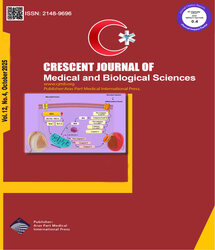

| Original Article | |
| Risk Factors and Prevention of Pulmonary Embolism in Young Adults | |
| Maryam Chenaghlou1, Razieh Parizad1,2,3, Mohammad Asghari Jafarabadi4 | |
| 1Cardiovascular Research Center, Tabriz University of Medical Sciences, Tabriz, Iran 2Faculty of Nursing and Midwifery, Tabriz University of Medical Sciences 3Faculty of Medical Sciences, Islamic Azad University, Tabriz, Iran 4Road Traffic Injury Research Center, Tabriz University of Medical Sciences, Tabriz, Iran |
|
|
CJMB 2017; 4: 007-012 Viewed : 4555 times Downloaded : 5772 times. Keywords : Pulmonary, Thromboembolism, Young adult |
|
| Full Text(PDF) | Related Articles | |
| Abstract | |
Objective: Pulmonary thromboembolism (PTE) importance is due to some reasons, first, it is one of the most common cardiovascular diseases, second it has high mortality and morbidity especially in some situations and third, prevention of this event is applicable and effective in most cases. The aim of this study was evaluation of predisposing factors of pulmonary emboli in young patients and defining preventive strategies in this age group. Materials and Methods: In this retrospective study, recorded data including age, sex, presentation month, chief complaint, vital signs at admission, positive findings of physical examination, venous thromboembolism (VTE) risk factors, laboratory and imaging findings of patients with pulmonary embolism diagnosis who had 45 years old or less from March 2008 to March 2014 in Shahid Madani Heart hospital, Tabriz, Iran were evaluated. Statistical analysis was done via SPSS version 21. Results: Eight hundred seventy patients had pulmonary emboli diagnosis during study period, 101 of them were ≤ 45 years old. Fifty-three patients were men and 48 of them were women. Mean age of patients was 33.6 years. Abnormal lower limb was the most frequent positive finding at physical examination. The important risk factor in women was hormonal change due to pregnancy or oral contraceptive pill use which was present in 50% of females. Smoking and immobilization due to surgery or trauma were the most common risk factor in men. Women had higher pulse rate (113.53± 21.84 vs 101.33 ± 20.27, P = 0.005) and lower hemoglobin (11.76 ± 2.00 vs 13.52 ± 2.21, P = 0.000) than men. The overall mortality rate was 10.8%. Conclusion: Although all the risk factors of pulmonary emboli were not evaluated in our patients but the determined ones seem to be modifiable in majority of cases. |
Cite By, Google Scholar
Google Scholar
PubMed
Online Submission System
 CJMB ENDNOTE ® Style
CJMB ENDNOTE ® Style
 Tutorials
Tutorials
 Publication Charge
Medical and Biological Research Center
About Journal
Publication Charge
Medical and Biological Research Center
About Journal
Aras Part Medical International Press Editor-in-Chief
Arash Khaki
Deputy Editor
Zafer Akan

















